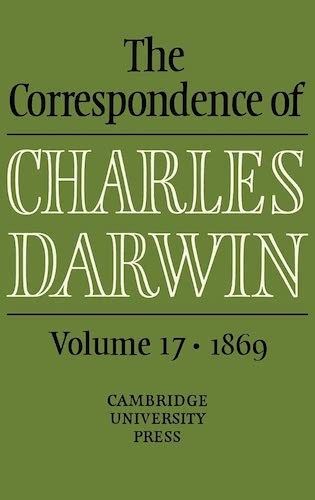
The seventeenth volume of Charles Darwin’s correspondence comprises all the surviving letters both from and to Darwin from the year 1869. During this year, Darwin continued his research into human evolution, human and animal emotions, and sexual selection. This would eventually result in two major books: The Descent of Man, and Selection in Relation to Sex and The Expression of the Emotions in Man and Animals. During the year, Darwin also revised On the Origin of Species for its fifth edition.
The year 1869 saw a major about-face by Darwin’s friend Alfred Russel Wallace. Although Wallace had arrived at the idea of natural selection independently of Darwin, he began to entertain serious doubts that it could explain human intellect and morality without the involvement of some higher power. Darwin was deeply distressed by Wallace’s apostasy, although the two remained on friendly and respectful terms.
Highlights from Darwin’s correspondence for 1869 include:
- A letter from a women’s suffrage campaigner about parrots.
- Darwin being ‘disgusted’ at the number of changes required for the fifth edition of On the Origin of Species, bearing in mind the previous edition had been published only two years earlier. He later observed, if he lived another twenty years, he would no doubt have to modify Origin and his views a great deal, but “it is a beginning, & that is something”.
- Wallace announcing he is dedicating what will become his most famous book, The Malay Archipelago, to Darwin. And Darwin saying this honour is something for his children’s children to be proud of. He later sent Wallace more feedback about the book.
- Darwin wondering how news of new nectar spreads through bee-hives, but supposing it is not communicated by the bees. (How he would have loved to know about the waggle-dance!)
- Darwin’s enthusiastic letter to James Croll regarding Croll’s hypothesis of asynchronous ice-periods in the northern and southern hemispheres.
- George Henslow’s strange hypothesis that the colouration of offspring can be affected by what their mother saw while pregnant.
- Wallace on the results of John Jenner Weir’s caterpillar experiments supporting Wallace’s hypothesis of protective colouration. (More here.)
- Thomas Henry Huxley’s cartoon of himself as a riled dog.
- Darwin summing up the main theoretical changes in the fifth edition of Origin.
- Darwin answering a questionnaire, saying his education only really began aboard HMS Beagle.
- Wallace warning Darwin about his forthcoming article expressing certain limitations on natural selection regarding human evolution, and Darwin’s joking response, “I hope you have not murdered too completely your own and my child”.
- Darwin, having subsequently read Wallace’s article, declaring ‘[I] differ grevously from you’. He goes on to express his disappointment in more detail to their mutual friend and inspiration Charles Lyell.
- Darwin’s thoughts on the term ‘struggle for existence’.
- Darwin being full of praise for Wallace’s recent review of two new editions of works by Lyell, and reporting ‘a baddish fall’ from his horse.
- One of a number of occasional letters to Darwin from religious nutters.
- Darwin’s first correspondence from the head of a Yorkshire lunatic asylum regarding the expression of emotions by various patients. See also: here, here, and here.
- Darwin asking his American friend Asa Gray to observe the colours of German men’s beards.
- …and asking another correspondent to observe the expression of emotions in women who are in labour.
- …and hearing from another correspondent who has provoked two Indian locals into a near-fight so he can observe their body-language for Darwin.
- Darwin enquiring about efficacy of “Pulvermachers Volta-Electric Chain bands” in relieving dyspepsia and nervous weakness.
- Darwin receiving a poem taking the piss out of teleology.
- Darwin defending his provisional (and incorrect) hypothesis of pangenesis in the popular science press.
- Darwin’s best friend, Joseph Dalton Hooker, being greatly disappointed by the new science journal ‘Nature’.
- Hooker explaining his reluctance to accept a knighthood.
- A correspondent suggesting a joint photograph be taken of Darwin and Wallace. Sadly, it was never to be. (Or maybe it was!)
As with all the volumes in this series, this book is really aimed at people with a serious interest in Charles Darwin. As with all the other volumes, every letter is annotated with meticulously researched footnotes explaining its context and references. The series as a whole is a masterpiece of scholarship.
- Buy this book from Amazon.co.uk
- Buy this book from Amazon.com
- Unfortunately, this book is not available on the bookshop.org website.